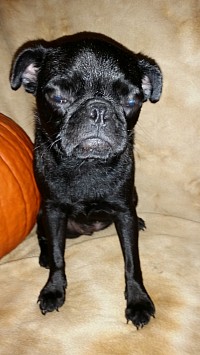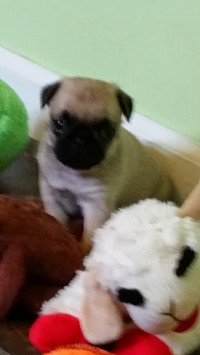AMERICAN KENNEL CLUB
http://www.vicjudges.com/pug/head.html#Ears
Pug Puppies
There's a lot of personality packed into the Pug's small, sturdy frame. Even-tempered, outgoing and playful, your Pug puppy will be happy to be wherever you are. He'll thrive in moderate temperatures, with lots of love and some exercise for both his muscular body and curious mind. His expressive face, charming personality and loving nature are irresistible.
For even more info about the pug breed. Enjoy!
www.i-love-pugs.com/pug-facts.html
training guide
http://pugs.cc/pug-information
MCKRELLS KENNEL (607)245-9782
THE PUG
Illustrated Standard
(AUSTRALIAN BREED STANDARD EXTENSION)
GENERAL APPEARANCE CHARACTERISTICS TEMPERAMENT HEAD AND SKULL EYES EARS MOUTH
NECK FOREQUARTERS BODY HINDQUARTERS FEET TAIL GAIT/MOVEMENT
COAT COLOUR HISTORY ACKNOWLEDGEMENTS
Head And Skull
Head relatively large, round, not apple-headed, with no indentation of skull. Muzzle relatively short, blunt, square, not upfaced. Nose fairly large with well open nostrils. Wrinkles on forehead clearly defined without exaggeration. Eyes or nose never adversely affected or obscured by over nose wrinkle. Pinched nostrils and heavy or over nose wrinkle is unacceptable and should be heavily penalised.
The first thing you notice about a pug is his head. It is the most prominent and striking feature on his body. Some people say it is what gives this breed its regal bearing.
Although the standard calls for a relatively large head, the head still must balance with the body and not look out of proportion... neither too large or too small.
The head should have a very short and well developed square foreface without the slightest sign of "turn up" of the nose.
Massive and round with wrinkles large and deep, it should be neither "flat faced" like the Pekingese, nor upfaced like the Bulldog.
The head has a distictively round shape yet the top of the skull is relatively flat.
Head wrinkles are important to give the breed its typical expression. The wrinkles on the forehead are deep and in a fan shape and they are set off by the darkening of the folds.The suplus skin under the throat and around the face form a large fold or ruff. The wrinkles on the forehead come together in a diamond shape sometimes called a thumb mark which is seen in fawn dogs.
The top of the skull is relatively flat. The black nose is set in the center of the face, the top of the nose being on a level with the center of the eyes. The nose must have well opened nostrils. The wrinkle above the nose should be unbroken, but it should not be penalised if it is "broken" or "split" in an otherwise excellent head.
Viewed from the side the muzzle should be as short and flat as possible and from the front it should be wide and well filled up under the eyes and almost equal to the width of the forehead. It should be in harmony with the rest of the head. The flews should not be pendalous but firm.
The lower jaw is as wide as possible and have a well-defined chin.The muzzle is covered by a dark mask which is evident in fawn dogs, as are the characteristic black beauty spots on each side of the cheeks.
Eyes
Dark, not too large, round in shape, soft and solicitous in expression, very lustrous, and when excited, full of fire. Never protruding, exaggerated or showing white. Free from obvious eye problems.
Every effort should be made to preserve correct head shape, and the soft and solicitous expression of those very large. bold, globular shaped eyes.
The standard does not mention that these large, dark eyes should be set well apart with black rims and in fawn dogs surrounded by a dark mask.
Ears
Rose ear
Button ear
Thin, small, soft like black velvet. Two kinds - 'Rose ear' - small drop ear which folds over and back to reveal the burr. 'Button ear' - ear flap folding forward, tip lying close to skull to cover opening. Preference given to latter.
The ears should be set on at the highest point on the skull. When alert the ear leather should not drop down further than the corner of the eye. The fold of the Button ear is level with the top of the skull and folds forward against the cheek. The Rose ear is small and neat and tends to give the head a more rounded look. The standard call for the burr to show (Bulldog type) but the common Rose ear is really just like the petal of a rose (see illustration above). The Button ear is the most common ear seen today. The size and shape of the ear should be in balance with the size of the skull.
Mouth
Slightly undershot. Wry mouth, teeth or tongue showing all highly undesirable. Wide lower jaw with incisors almost in a straight line.
The key here is the wide underjaw! The underjaw must also be deepand the lipline viewed from the front must be a gentle curve and not an abrupt upside down V shape (froggy) and not hidden by heavy flews. There is not usually any reason to open a Pug's mouth. Use your thumb to feel the slight undershot bite. If the lipline is correct and the line from the nose to the mouth (naso-labial line) is straight up and down, and the teeth or tongue not showing, the mouth is usually correct.
Summary
Next page > >
Page 2
Illustrated Standard prepared by Judy Horton - (All Breeds judge) for the VicJudge's website Australia
webpage-world.com


